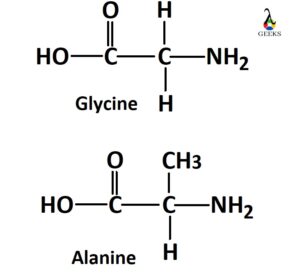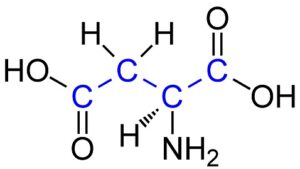In this article, “aspartic acid structure” structure and representation with some detailed explanations are discussed briefly.
Aspartic acid is basically one acidic α amino acid with an amino group (NH2) and carboxylic acid group (COOH). Its molar mass is 133.103 g/mol with boiling and melting point 3240 C and 2700 C respectively. It is uses as the biosynthetic element of protein synthesis.
Main outlook of this article is to give the structural explanation of aspartic acid through the following points.
What is amino acid?
Amino acid is organic molecular species having one amino and one carboxylic acid group. Amino acids are combined with each other to form protein molecule. Thus, they are called the building block in living organism body. There are total 21 amino acids are discovered in science.
Amino acid can be classified into following category-
- Essential amino acid
- Non-essential amino acid
- Conditionally essential amino acid
Essential amino acids are defined as those amino acid cannot be synthesized in our body. Total nine amino acids are included as essential amino acid like phenylalanine, valine, threonine, tryptophan, methionine, leucine, isoleucine, lysine and histidine.
The six non-essential amino acids which can be easily synthesized in living body. They are alanine, aspartic acid, asparagine, glutamic acid, serine and selenocysteine.
There are six conditionally essential amino acids which can be synthesized in our body but is limited under special pathophysiological condition. For example, arginine, cysteine, glycine, glutamine, proline and tyrosine.

Image Credit: Wikimedia Commons.
Methods of Drawing Amino Acid Structure
Amino acid consists of these three parts-
- Amino group or known as NH2 group
- Carboxylic acid group or COOH group
- Alpha carbon containing a R group
Different amino acid contains different R group and the amino acid differs from one another because of the different R group.
The methods of drawing the structure of amino acid is described below-
- The general skeleton should be written first containing one amino group, one carboxylic acid group and the alpha carbon atom. Two of the simplest alpha amino acid are glycine and alanine.

- Then fisher projection structure of the amino acid will be drawn. From the fisher projection the R or S projection of any amino acid can be easily determined. If the amino acid possesses S projection then COOH group must be kept at the top and amino group (NH2) group must be on the left of the alpha carbon atom.
- Now it’s the time to decide whether the amino acid is basic, acidic or neutral in nature depending upon the number of functional group (COOH group or NH2 group). If the number of COOH group is greater than NH2 group then it is called acidic amino acid (aspartic acid, glutamic acid). If number of NH2 group is greater than COOH group then it will be regarded as basic amino acid (Arginine and histidine) and if both the functional group is present in 1:1 ratio then the amino acid will be neutral amino acid (glycine, alanine).
- Now at last zwitter ionic form (one type of representation containing both the positive and negative charge making the whole species electrically neutral) of amino acid will be written.
Aspartic Acid Structure and Hybridization
Aspartic acid is an example of alpha amino acid (dicarboxylic amino acid) with acidic character. The ionic form of this amino acid is known as aspartate. Under physiological condition (pH = 7.4), the amino group (NH2 group) is protonated and becomes NH3+ but carboxylic acid group (COOH group) is deprotonated and present as COO–.
Aspartic acid is acidic in nature (pka = 3.9) due to presence of acidic side chain (CH2COOH). It is a non-essential amino acid which our body can easily synthesize.
Aspartic acid is present as two enantiomeric form, D-aspartic acid and L-aspartic acid. Between these two amino acids, only L-amino acid can be directly incorporated into the protein chain. But in most of the case in time of synthesis of aspartic acid, both the D and L form is synthesized at the same time.
Due to presence of two carboxylic acid group (COOH group), aspartic acid is hydrophilic in nature. This molecule is negatively charged under neutral pH (pH= 7). Because of the hydrophilic nature, aspartic acid is found at the surface of the protein chain. The isoelectric point of aspartic acid 2.77 (acidic isoelectric point)

Image Credit: Wikimedia Commons.
The carbon atom of both the carboxylic acid group is sp2 hybridized having trigonal planar geometry and bond angle 1200. Rest of the carbon atoms (alpha carbon and carbon atom of CH2 group) are sp3 hybridized having tetrahedral structure and bond angle 109.50. Nitrogen atom of NH2 group and carbon atom from carbonyl group (C=O) have sp3 and sp2 hybridization respectively.
Frequently Asked Questions (FAQ)
Is aspartic acid soluble in water?
Answer: Due to presence of two carboxylic acid group and polarity, aspartic acid is very much soluble in water (solubility in water is 4.5 g/L).
How aspartic acid can be synthesized in living organism body?
Answer: As it is non-essential amino acid, it can be synthesized in living body by the transmission process of oxaloacetate and this process gets momentum by the enzyme known as aminotransferase.
Also, please click to learn about PBr5 lewis Structure and PBr3 Lewis Structure.

Hello,
I am Aditi Ray, a chemistry SME on this platform. I have completed graduation in Chemistry from the University of Calcutta and post graduation from Techno India University with a specialization in Inorganic Chemistry. I am very happy to be a part of the Lambdageeks family and I would like to explain the subject in a simplistic way.
Let’s connect through LinkedIn-https://www.linkedin.com/in/aditi-ray-a7a946202